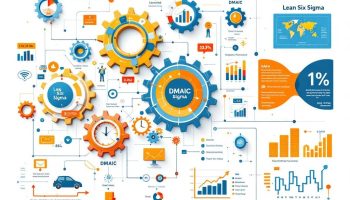
Understanding 5S Kaizen Lean Six Sigma DFSS Methodologies
5S Kaizen Lean Six Sigma DFSS combines five complementary approaches that create a complete framework for operational excellence. These methodologies work together to establish structured environments where waste disappears, processes become standardized, and quality integrates into every operational aspect.
Driving Business Transformation Through Integrated Excellence
5S Kaizen Lean Six Sigma DFSS methodologies offer businesses systematic tools to tackle key challenges in today’s competitive market. Implementing these approaches helps your organization cut operational costs by eliminating waste, boost product quality through statistical process control, increase customer satisfaction with consistent specification adherence, and develop a continuous improvement culture that sparks innovation. Quality management experts confirm this integrated excellence framework helps companies respond quickly to market shifts while maintaining operational discipline and statistical precision in improvement projects.
The implementation of 5S principles (Sort, Set in order, Shine, Standardize, and Sustain) creates the foundation for other improvement methodologies. Kaizen practices build on this foundation by encouraging small, incremental changes that add up to significant improvements. Lean principles focus on removing non-value-adding activities, while Six Sigma provides statistical tools to reduce variation. DFSS (Design for Six Sigma) completes the framework by ensuring quality is designed into products and processes from the beginning.
Your company can achieve remarkable results by applying these methodologies together rather than in isolation. The synergy between these approaches leads to better problem-solving capabilities, reduced defects, shorter lead times, and improved employee engagement.
Discover 5 Essential 5S Kaizen Lean Six Sigma DFSS Practices for Operational Excellence
In today’s competitive landscape, organizations must adopt effective methodologies to enhance productivity and quality. The integration of 5S, Kaizen, Lean, Six Sigma, and Design for Six Sigma (DFSS) serves as a powerful framework for streamlining operations. This section outlines five foundational practices that will help you implement these principles successfully. Each practice emphasizes a unique aspect of continuous improvement, waste elimination, and quality enhancement. By mastering these essential elements, your team can foster a culture of excellence, driving sustained organizational growth and performance. Whether you are new to these concepts or looking to refine your approach, these key practices are vital for creating a high-performing environment that supports your operational goals.
1. The Foundation of 5S: Workplace Organization
Implementing 5S Kaizen Lean Six Sigma DFSS principles begins with establishing an organized workplace. The 5S methodology creates a foundation for continuous improvement by eliminating waste and standardizing processes. You can transform your work environment by applying these five Japanese principles:
- Sort (Seiri): Remove unnecessary items from the workspace
- Set (Seiton): Arrange essential tools and materials in optimal locations
- Shine (Seiso): Clean and inspect the work area regularly
- Standardize (Seiketsu): Establish consistent procedures for the first three S’s
- Sustain (Shitsuke): Maintain discipline through audits and accountability
Creating visual workplace management systems helps make abnormalities immediately apparent. You can implement color-coding, shadow boards, and floor markings to communicate information visually. These systems support continuous improvement efforts by making standards visible and deviations obvious.
Measuring workplace efficiency through 5S metrics provides quantifiable evidence of improvement. Track metrics like setup time reduction, space utilization, and safety incidents to demonstrate the impact of your 5S implementation.
2. Kaizen: Driving Continuous Improvement Culture
Implementing 5S Kaizen Lean Six Sigma DFSS principles starts with establishing a culture of continuous improvement. Kaizen, which means “change for better” in Japanese, creates an environment where every employee contributes to organizational growth through small, incremental improvements.
Daily Kaizen activities provide the foundation for operational excellence. You can implement suggestion systems where employees submit ideas to enhance processes related to 5S or other Lean methodologies. These small improvements, when accumulated, create significant positive change in your operations.
Kaizen events offer opportunities for rapid process improvement by focusing cross-functional teams on specific problems for 3-5 days. During these events, you’ll analyze current states, identify waste, and implement immediate solutions using Lean Six Sigma tools.
Building employee engagement requires creating improvement circles where teams meet regularly to:
- Identify process issues affecting quality or efficiency
- Analyze root causes using Six Sigma techniques
- Implement and test solutions
- Document standard work procedures
Success depends on tracking improvements through metrics like lead time reduction, defect rates, and productivity gains. By measuring these incremental changes, you demonstrate the value of your Kaizen initiatives and maintain momentum for continuous improvement.
Expert Insight: Foster a culture of continuous improvement by implementing daily Kaizen activities and suggestion systems, empowering employees to drive incremental changes. Organize Kaizen events to tackle specific problems with cross-functional teams and utilize metrics to track progress, demonstrating the impact of these initiatives on operational excellence.
3. Lean Manufacturing: Eliminating Waste
Lean manufacturing focuses on waste elimination, a core principle of 5S, Kaizen, Lean Six Sigma, and DFSS methodologies. By identifying and removing the eight types of waste (DOWNTIME: Defects, Overproduction, Waiting, Non-utilized talent, Transportation, Inventory, Motion, and Excess processing), you can significantly improve operational efficiency.
Implementing pull systems alongside Just-in-Time production helps you reduce unnecessary inventory while ensuring materials arrive precisely when needed. This approach, central to lean thinking, minimizes holding costs and prevents overproduction issues that plague many manufacturing operations.
Value stream mapping offers a powerful visualization tool for process optimization. By creating detailed value stream maps, you can identify bottlenecks and non-value-adding activities throughout your production process. These maps serve as the foundation for targeted improvement activities.
Establishing flow and calculating takt time helps synchronize your production pace with customer demand. When you properly implement flow, work moves seamlessly between operations without batching or delays. Consider the following key elements:
- Eliminating process islands that interrupt continuous flow
- Balancing workloads across operations to prevent bottlenecks
- Using visual management to maintain flow discipline
- Implementing standardized work to ensure consistency
Expert Insight: To enhance operational efficiency, prioritize waste elimination in lean manufacturing by addressing the eight types of waste. Implement pull systems and Just-in-Time production to streamline inventory management, while utilizing value stream mapping to identify bottlenecks. Establish flow by balancing workloads and maintaining consistency through standardized work.
4. Six Sigma: Statistical Process Control in 5S Kaizen Lean Environments
Six Sigma statistical process control integrates perfectly with 5S Kaizen Lean Six Sigma DFSS methodologies to drive significant quality improvements. When you implement the DMAIC (Define, Measure, Analyze, Improve, Control) methodology, you create a structured approach to problem-solving that eliminates defects and reduces variation.
Statistical tools form the backbone of Six Sigma implementation. You can leverage control charts, hypothesis testing, and regression analysis to identify root causes of variation in your processes. These powerful analytical techniques help you make data-driven decisions rather than relying on gut feelings or assumptions.
Process capability studies are essential for measuring how well your processes meet specifications. By calculating metrics like Cpk and Ppk, you quantify your process performance against customer requirements. A Six Sigma Black Belt project typically includes these measurements to demonstrate improvements.
The following statistical tools are commonly employed in Six Sigma initiatives:
- Statistical Process Control (SPC) charts for monitoring process stability
- Measurement System Analysis (MSA) for validating data collection methods
- Design of Experiments (DOE) for optimizing process parameters
- Failure Mode and Effects Analysis (FMEA) for risk mitigation
Developing comprehensive control plans ensures your continuous improvement efforts remain sustainable over time. These plans document monitoring methods, reaction procedures, and responsibilities for maintaining process controls.
Expert Insight: Integrate Six Sigma with 5S Kaizen Lean methodologies to enhance quality through structured problem-solving using DMAIC. Employ statistical tools like control charts and process capability studies to identify variations and ensure data-driven decisions, fostering sustainable continuous improvement in your processes.
5. Design for Six Sigma (DFSS): Building Quality from Start
Design for Six Sigma (DFSS) embeds quality principles early in your development process, making it a cornerstone of the 5S Kaizen Lean Six Sigma DFSS methodology. Unlike traditional Six Sigma that improves existing processes, DFSS focuses on designing quality from the beginning.
The DMADV (Define, Measure, Analyze, Design, Verify) framework guides you through creating processes that meet Six Sigma quality levels. Start by incorporating Voice of Customer (VOC) data to ensure your designs address actual customer needs rather than assumed requirements. This customer-centric approach helps you identify key stakeholders whose input is crucial for success.
Design of Experiments (DOE) techniques allow you to test multiple variables simultaneously, identifying optimal parameter settings before full implementation. This systematic testing approach reduces development time while increasing design reliability.
Key DFSS implementation strategies include:
- Applying quality function deployment to translate customer requirements into technical specifications
- Using simulation tools to predict process performance
- Implementing design scorecards to track critical quality elements
- Establishing validation protocols to verify design effectiveness
By embracing continuous improvement through DFSS, you ensure products and services consistently meet high-quality standards from conception through delivery.
Expert Insight: Incorporate Design for Six Sigma principles early in your development process to ensure quality by design. Utilize the DMADV framework and Voice of Customer data to create customer-centric designs. Employ Design of Experiments techniques to optimize variables, enhancing reliability and reducing development time.
5S Kaizen Lean Six Sigma DFSS
5S Kaizen Lean Six Sigma DFSS represents a comprehensive framework of five complementary methodologies that drive operational excellence through systematic improvement. These approaches work synergistically to create organized workspaces, foster a continuous improvement culture, eliminate waste, reduce process variation, and design quality into products and processes from inception.
Importance of 5S Kaizen Lean Six Sigma DFSS
5S Kaizen Lean Six Sigma DFSS methodologies are essential for modern enterprises facing intense competitive pressures and escalating customer expectations. By implementing these integrated approaches, organizations can:
- Significantly reduce operational costs
- Enhance product quality
- Accelerate delivery times
- Build sustainable competitive advantages through standardized processes
These methodologies consistently deliver exceptional value to customers.






